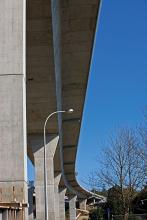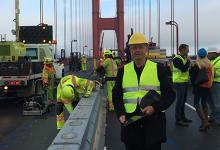The bridge over Auckland Harbour celebrates its half century this year, and it has been given a major upgrade to ensure that safety is maintained in New Zealand's largest city. Mary Searle reports. Auckland is New Zealand's largest city, home to nearly a third of the entire country's population. It's a sprawling metropolis, and its 1.3 million people are spread over 637km² of city, suburbs and islands. The Auckland Harbour Bridge, which celebrates its 50th birthday in May, is a vital link in the city's road
The bridge over Auckland Harbour celebrates its half century this year, and it has been given a major upgrade to ensure that safety is maintained in New Zealand's largest city. Mary Searle reports
Auckland is New Zealand's largest city, home to nearly a third of the entire country's population. It's a sprawling metropolis, and its 1.3 million people are spread over 637km² of city, suburbs and islands.The Auckland Harbour Bridge, which celebrates its 50th birthday in May, is a vital link in the city's road network. Each day more than 170,000 vehicles use it, a far cry from the paltry 8,250 vehicles it was originally designed for.
Within 10 years of it being built the bridge was widened from its original four lanes to eight with the addition of box girders on either side of the bridge with two lanes on each, supported by the bridge piers and independent of the superstructure. And still traffic volumes grew.
During peak hours a large percentage of this traffic is commuters, heading south in the morning into the city and home again to the North Shore suburbs in the evening.
This tidal flow of traffic puts great demands on the eight-lane bridge, so overhead lane signals and a moveable lane barrier increases capacity. Each day, the southern transfer machine moves north, moving the barrier from right to left to create three lanes north and five lanes south for the morning commute into the city. Once rush hour has passed, it heads south again, moving the barrier back to the centre, allowing four lanes of traffic in each direction. As the evening rush approaches the northern barrier machine creates five lanes north and three south, restoring it to four later in the evening.
The barrier was first installed in 1990 to prevent cross-centreline head-on collisions. In the five years to 1988 there had been 10 fatalities between vehicles travelling in opposite directions, and in 1989 another five people lost their lives in head-on crashes on the bridge.
The moveable lane barrier eliminated cross-centre line incidents altogether, with not a single fatality recorded since its installation. This in itself makes the barrier a resounding success. However, in having a concrete barrier between northbound and southbound traffic, vehicle numbers in the centre lanes increased as travellers felt more comfortable using them with the accident risk substantially reduced, and consequently the bridge's throughput rose.
Nearly 20 years on, the Auckland Harbour Bridge moveable lane barrier continues to work well and has become the longest serving, permanent use moveable lane barrier in the world. However, after two decades' service, the transfer machines had long passed their life expectancy and they and the barrier itself were replaced in late February.
As the Auckland Harbour Bridge is such a critical piece of the city's infrastructure, the barrier replacement had to be carried out with as little impact on the travelling public as possible (in the middle of the night over a weekend).
The project was spread over two nights, the first to install the new barrier, the second to remove the old. The whole job needed to be completed by 4.30 on the Monday morning in time to move the new barrier into place for the weekday commuter traffic.
This was no simple task. The new barrier comprises 2,000 sections, each made up of two pieces of concrete barrier linked together. The project required eight forklifts, 16 trucks, numerous traffic control vehicles to manage the detours and closures on the approaches to the bridge, and a team of men putting in the pins that link the sections together. A total of 50 people were on the bridge for the project, from truck and forklift drivers and the men connecting the barrier pieces, to the traffic control team, the police, staff from bridge owners the
Planning for the replacement of the barrier began months in advance. The concrete sections were manufactured in New Zealand and stored on site in November 2008. Excitement rose with the arrival on 7 February of the ship carrying the new barrier transfer machines. Two days later they were trucked to site, given their new livery of NZTA branding and the operators underwent a training day to familiarise themselves with the new machines.
Things looked a little uncertain weatherwise in the lead up to the big event, with gale force winds and rain predicted for the weekend of 28th February - 1st March. Not that this would affect the barrier installation itself, but high winds can play havoc with traffic control cones and that would force a postponement of the project. As it was, the storm blew through early and by the time Saturday evening approached Auckland had returned to the muggy calm weather it usually experiences in late summer.
Things got underway with a safety briefing at 6pm and work started two hours later with southbound traffic restricted to the two outer clip-on lanes and northbound traffic restricted to three lanes.
Ideally the four central lanes of the bridge, separated from the clip-ons by the bridge's superstructure, would have been closed to traffic for this operation, but the box girders are currently undergoing strengthening work and, as a result, heavy vehicles are not permitted to use the clip-on lanes. So the workers were separated from the northbound traffic by the old moveable lane barrier.
The new 2.2km long barrier was put in place by two teams that started in the middle, one moving north, the other south. For ease of assembly the barrier sections were already bolted together in pairs. Each pair was loaded onto trucks by forklifts with a specially designed attachment that allowed them to easily pick them up and place them lengthwise. The sections were then transported the short distance from the on site storage area at the northern end of the bridge to where the barrier was being assembled. There another pair of forklifts unloaded the sections, carefully placing them end-to-end so the connecting pin could be positioned and then hydraulically driven into place.
Once each truck was unloaded it headed off to be reloaded, a process which continued all night.
By 9am on Sunday morning the barrier was installed and the bridge almost fully reopened to traffic - four lanes southbound were open and three northbound. The lane between the old barrier and the new was left unused for the day.
On Sunday evening the central northbound lanes of the bridge were closed, leaving traffic to use the clip-on lanes and the barrier transfer machine moved from north to south shifting the new barrier to the left. This left the two southbound clip-ons for the travelling public and the far left lane of the central bridge (nearest the southbound clip-on) open for northbound heavy vehicles.
And so the process started again. Once more beginning in the middle, the team reversed its operations to dismantle the old barrier.
They had from 8pm until 4.30am to do this, when the new barrier was scheduled to be shifted across two lanes to open five lanes for the Monday morning southbound rush hour traffic.
Things went very smoothly throughout the project, especially when you consider that this is a once-in-20 year's task for the Auckland Harbour Bridge and, as a result, most of the people on the job hadn't done this or anything like it before.'
The men connecting the barrier were from the road maintenance crew at
As the project was carried out overnight, the disruption to the public was minimal. A slight time overrun on Monday morning caused congestion problems up the Northern Motorway and not insignificant delays to commuters, but all lanes were open by 7am and by 9.30am things were back to normal.
A brief history of the bridge
Plans for a bridge across Auckland's Waitemata Harbour date back as far as 1860, but it took 99 years from those first plans to the bridge opening.
Although the authorities acknowledged a bridge was needed (transport across the harbour was by ferry) a Royal Commission in 1946 gave extremely low predictions of traffic use, stating that only 8,250 cars would use the bridge daily by 1965. That figure was exceeded in 1959, the year the bridge opened.
From day one, traffic on the bridge has risen exponentially. Vehicle numbers quickly moved from 13,500/day in 1959 to 42,000/day 10 years later.
It soon became clear the bridge needed to be expanded and in 1969 new prefabricated steel sections were bolted on to the outer edges of the bridge: box girders, two lanes on each, supported by the piers and independent of the superstructure. The box girders were supplied by the Japanese firm Ishikawajima-Harima, and were immediately dubbed locally as the "Nippon clip-ons."
By 1980 traffic numbers had reached 72,000 vehicles/day and overhead lane signals were installed to provide tidal operation during morning and evening peaks.
By 1988 daily vehicle numbers were at 120,000 and with this rise in traffic the number of head-on accidents also increased.
The Auckland Harbour Bridge has a 5% gradient on its approach ramps as well as horizontal curves on both approaches which combine to effectively reduce lines of sight as well as increasing demands on drivers travelling at speed (the speed limit is 80km/hr) and in close proximity to vehicles travelling in the opposite direction.
The number of head-on fatalities was rising.
Martin Leak of Resolve Group, who led the establishment of the original barrier system and has continued his leadership with this latest installation, says he received a phone call from a woman who'd lost someone in a head-on accident on the bridge and who asked him, "why can't you put up a barrier?"
"Unfortunately, a permanent barrier was not a viable solution, as it would create unacceptable traffic congestion. However, after seeing a video of a moveable barrier in action I knew I'd found a solution.
"I couldn't put my hand over my heart and say there's nothing we could do."
So in 1988 investigations were started into the possibility of installing a moveable lane barrier. The following year Transit (as the New Zealand Transport Agency was then called) approved a moveable lane barrier project and planning began. In November 1990 the barrier was installed.
When last counted in 2006, traffic numbers across the bridge were at 170,000 daily.
As the bridge celebrates its 50th birthday, it is undergoing work to strengthen the box girders and prolong their life.










